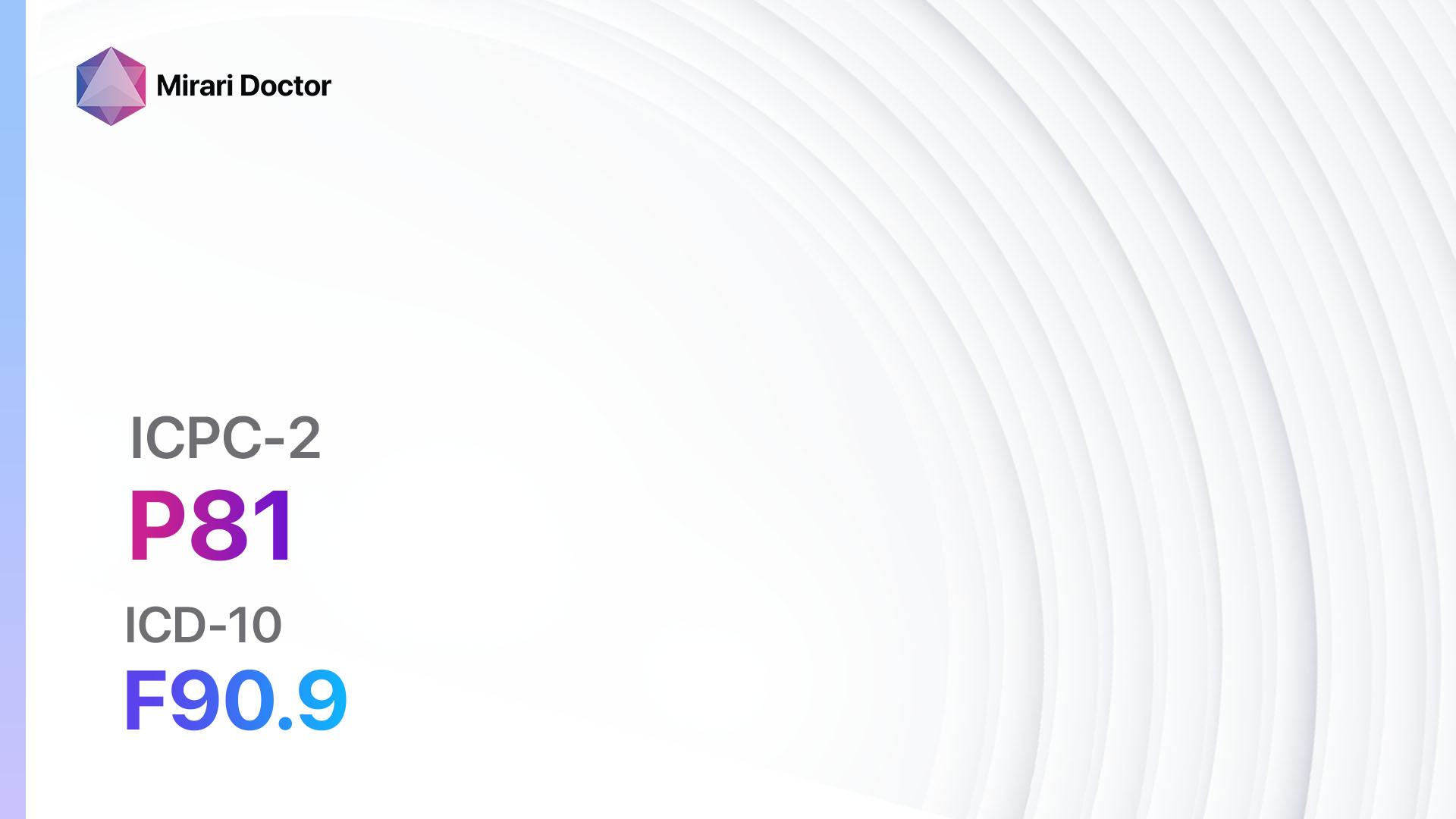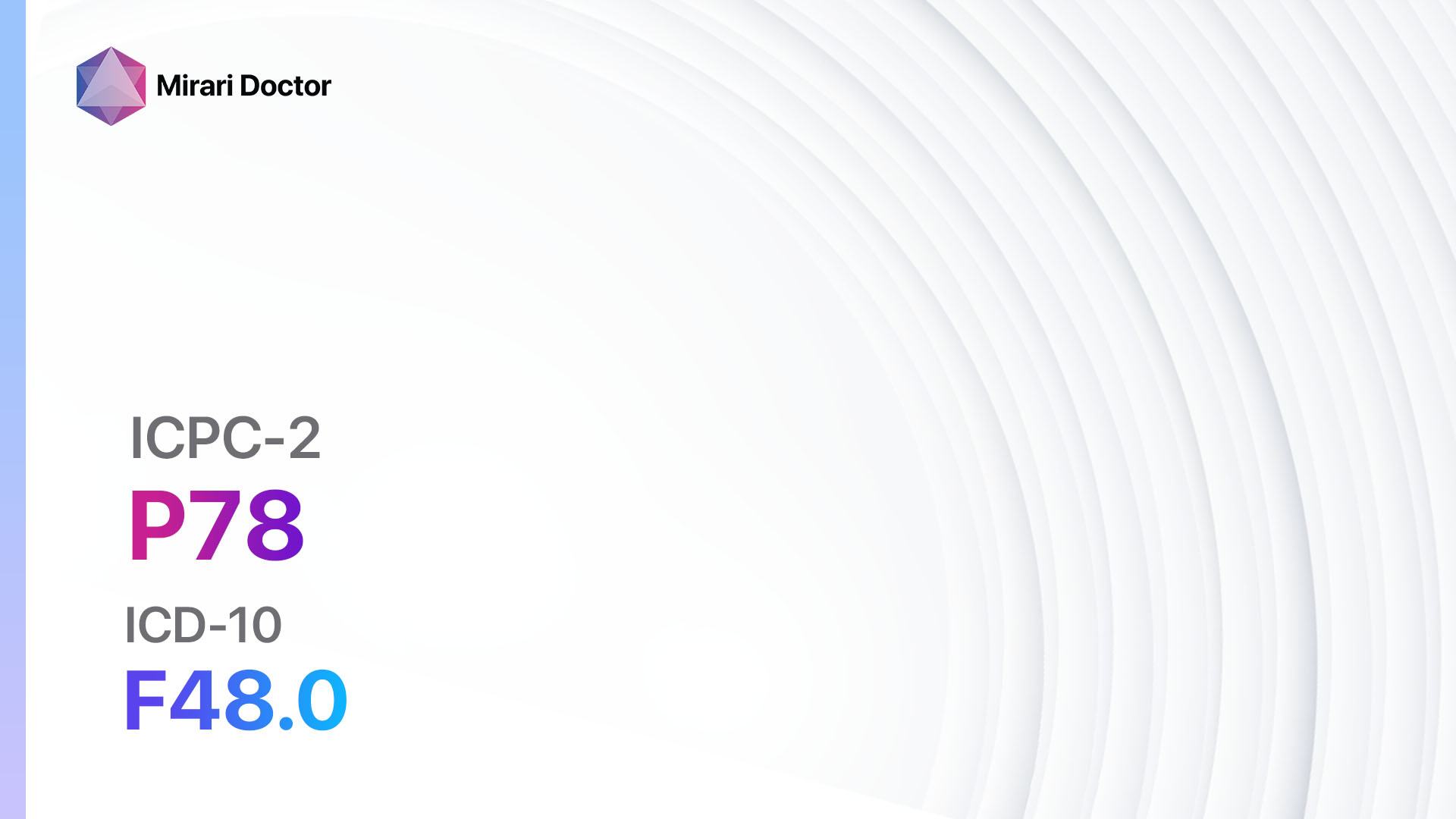
Introduction
Reduced sexual desire, also known as hypoactive sexual desire disorder (HSDD), is a condition characterized by a persistent or recurrent lack of sexual fantasies or desire for sexual activity. It can significantly impact an individual’s quality of life and relationships.[1] The aim of this guide is to provide healthcare professionals with a comprehensive approach to diagnosing and managing reduced sexual desire in patients.
Codes
- ICPC-2 Code: P07 Sexual desire reduced
- ICD-10 Code: F52.0 Lack or loss of sexual desire
Symptoms
- Lack of sexual fantasies or thoughts
- Absence of desire for sexual activity
- Reduced interest or pleasure in sexual activities
- Lack of sexual initiation or responsiveness[2]
Causes
- Hormonal imbalances, such as low testosterone levels
- Psychological factors, including stress, depression, anxiety, or relationship issues
- Medical conditions, such as diabetes, cardiovascular disease, or chronic pain
- Medications, including certain antidepressants or antihypertensives
- Substance abuse or addiction
- Previous traumatic experiences or sexual abuse[3]
Diagnostic Steps
Medical History
- Gather information about the patient’s sexual history, including any previous sexual problems or concerns.
- Assess the presence of any medical conditions or medications that may contribute to reduced sexual desire.
- Evaluate the patient’s psychological well-being, including any history of depression, anxiety, or relationship issues.
- Inquire about any recent life events or stressors that may be affecting the patient’s sexual desire.[4]
Physical Examination
- Perform a general physical examination to assess overall health and identify any physical conditions that may contribute to reduced sexual desire.
- Evaluate the patient’s hormone levels, including testosterone, to rule out hormonal imbalances.
- Assess the patient’s genitalia for any physical abnormalities or signs of underlying medical conditions.[5]
Laboratory Tests
- Testosterone levels: Measure total and free testosterone levels to assess for hormonal imbalances.
- Thyroid function tests: Evaluate thyroid hormone levels to rule out any thyroid disorders that may contribute to reduced sexual desire.
- Blood glucose levels: Check fasting blood glucose levels to screen for diabetes, which can affect sexual function.
- Lipid profile: Assess lipid levels to identify any cardiovascular risk factors that may contribute to reduced sexual desire.
- Prolactin levels: Measure prolactin levels to rule out any abnormalities that may affect sexual desire.[6]
Diagnostic Imaging
- Pelvic ultrasound: Use ultrasound imaging to assess the pelvic organs and identify any structural abnormalities that may contribute to reduced sexual desire.
- Magnetic resonance imaging (MRI): Perform an MRI scan to evaluate the brain and rule out any central nervous system abnormalities that may affect sexual desire.[7]
Other Tests
- Psychological assessment: Conduct a psychological evaluation to assess for any underlying psychological factors that may contribute to reduced sexual desire.
- Sexual desire questionnaires: Use validated questionnaires, such as the Female Sexual Function Index (FSFI) or the International Index of Erectile Function (IIEF), to assess the severity of reduced sexual desire.[8]
Follow-up and Patient Education
- Schedule regular follow-up appointments to monitor the patient’s progress and adjust the treatment plan as needed.
- Provide patient education on the potential causes of reduced sexual desire and the available treatment options.
- Offer counseling or psychotherapy referrals for patients who may benefit from additional psychological support.[9][10]
Possible Interventions
Traditional Interventions
Medications:
Top 5 drugs for reduced sexual desire:
- Testosterone replacement therapy:
- Cost: $50-$200 per month.
- Contraindications: Prostate or breast cancer, severe cardiac or hepatic disease.
- Side effects: Acne, fluid retention, mood changes.
- Severe side effects: Increased risk of cardiovascular events, liver toxicity.
- Drug interactions: Anticoagulants, insulin.
- Warning: Regular monitoring of testosterone levels and prostate health required.
- Selective serotonin reuptake inhibitors (SSRIs):
- Cost: $10-$50 per month.
- Contraindications: Concurrent use of monoamine oxidase inhibitors (MAOIs).
- Side effects: Nausea, sexual dysfunction, weight gain.
- Severe side effects: Serotonin syndrome, suicidal thoughts.
- Drug interactions: MAOIs, other serotonergic medications.
- Warning: Gradual tapering required to discontinue use.
- Bupropion:
- Cost: $10-$50 per month.
- Contraindications: Seizure disorder, eating disorder.
- Side effects: Insomnia, dry mouth, headache.
- Severe side effects: Seizures, allergic reactions.
- Drug interactions: MAOIs, antipsychotics.
- Warning: Increased risk of suicidal thoughts in young adults.
- Phosphodiesterase type 5 inhibitors (PDE5 inhibitors):
- Cost: $10-$50 per tablet.
- Contraindications: Nitrates, severe cardiac disease.
- Side effects: Headache, flushing, indigestion.
- Severe side effects: Priapism, sudden hearing loss.
- Drug interactions: Alpha-blockers, antihypertensives.
- Warning: Use with caution in patients with cardiovascular disease.
- Oxytocin nasal spray:
- Cost: $50-$100 per bottle.
- Contraindications: Hypersensitivity to oxytocin.
- Side effects: Nausea, headache, nasal irritation.
- Severe side effects: Allergic reactions, hyponatremia.
- Drug interactions: None reported.
- Warning: Use with caution in patients with cardiovascular disease.
Alternative Drugs:
- Buspirone: An anxiolytic medication that may help improve sexual desire. Cost: $10-$50 per month.
- Mirtazapine: An antidepressant that can increase sexual desire. Cost: $10-$50 per month.
- Pramipexole: A medication used for Parkinson’s disease that may enhance sexual desire. Cost: $10-$50 per month.
- Bremelanotide: A melanocortin receptor agonist that can increase sexual desire. Cost: $500-$1,000 per month.
- Flibanserin: A medication specifically approved for the treatment of HSDD in premenopausal women. Cost: $400-$800 per month.
Surgical Procedures:
- None: There are currently no surgical procedures specifically indicated for the treatment of reduced sexual desire.
Alternative Interventions
- Couples therapy: Involves counseling sessions with both partners to address relationship issues and improve communication. Cost: $75-$200 per session.
- Sex therapy: Focuses on addressing sexual concerns and improving sexual function through counseling and education. Cost: $75-$200 per session.
- Mindfulness-based stress reduction: A technique that combines meditation, yoga, and body awareness to reduce stress and improve overall well-being. Cost: $100-$300 for an 8-week program.
- Herbal supplements: Some herbal supplements, such as maca root or ginseng, may have potential benefits for improving sexual desire. Cost: Varies depending on the specific supplement.
- Acupuncture: May help improve sexual desire by promoting relaxation and improving blood flow. Cost: $60-$120 per session.
Lifestyle Interventions
- Regular exercise: Engaging in regular physical activity can improve overall well-being and increase sexual desire. Cost: Varies depending on the chosen exercise regimen.
- Stress management: Learning stress reduction techniques, such as meditation or deep breathing exercises, can help improve sexual desire. Cost: Varies depending on the chosen stress management method.
- Healthy diet: Consuming a balanced diet rich in fruits, vegetables, whole grains, and lean proteins can support overall sexual health. Cost: Varies depending on individual food choices.
- Adequate sleep: Getting enough sleep is essential for maintaining overall health and sexual well-being. Cost: Varies depending on individual sleep habits and any necessary interventions for sleep disorders.
- Open communication: Encouraging open and honest communication with sexual partners can help address relationship issues and improve sexual desire. Cost: None.
It is important to note that the cost ranges provided are approximate and may vary depending on the location and availability of the interventions. Additionally, the effectiveness of alternative interventions may vary from person to person, and it is recommended to consult with a healthcare professional before starting any new treatment.
Mirari Cold Plasma Alternative Intervention
Understanding Mirari Cold Plasma
- Safe and Non-Invasive Treatment: Mirari Cold Plasma is a safe and non-invasive treatment option for various skin conditions. It does not require incisions, minimizing the risk of scarring, bleeding, or tissue damage.
- Efficient Extraction of Foreign Bodies: Mirari Cold Plasma facilitates the removal of foreign bodies from the skin by degrading and dissociating organic matter, allowing easier access and extraction.
- Pain Reduction and Comfort: Mirari Cold Plasma has a local analgesic effect, providing pain relief during the treatment, making it more comfortable for the patient.
- Reduced Risk of Infection: Mirari Cold Plasma has antimicrobial properties, effectively killing bacteria and reducing the risk of infection.
- Accelerated Healing and Minimal Scarring: Mirari Cold Plasma stimulates wound healing and tissue regeneration, reducing healing time and minimizing the formation of scars.
Mirari Cold Plasma Prescription
Video instructions for using Mirari Cold Plasma Device – P07 Sexual desire reduced (ICD-10:F52.0)
| Mild | Moderate | Severe |
| Mode setting: 8 (Insomnia) Location: 7 (Neuro system & ENT) Morning: 15 minutes, Evening: 15 minutes |
Mode setting: 8 (Insomnia) Location: 7 (Neuro system & ENT) Morning: 30 minutes, Lunch: 30 minutes, Evening: 30 minutes |
Mode setting: 8 (Insomnia) Location: 7 (Neuro system & ENT) Morning: 30 minutes, Lunch: 30 minutes, Evening: 30 minutes |
| Mode setting: 5 (Prostatitis Therapy) Location: 2 (Prostate & Uterus) Morning: 15 minutes, Evening: 15 minutes |
Mode setting: 5 (Prostatitis Therapy) Location: 2 (Prostate & Uterus) Morning: 30 minutes, Lunch: 30 minutes, Evening: 30 minutes |
Mode setting: 5 (Prostatitis Therapy) Location: 2 (Prostate & Uterus) Morning: 30 minutes, Lunch: 30 minutes, Evening: 30 minutes |
| Mode setting: 7 (Immunotherapy) Location: 1 (Sacrum) Morning: 15 minutes, Evening: 15 minutes |
Mode setting: 7 (Immunotherapy) Location: 1 (Sacrum) Morning: 30 minutes, Lunch: 30 minutes, Evening: 30 minutes |
Mode setting: 7 (Immunotherapy) Location: 1 (Sacrum) Morning: 30 minutes, Lunch: 30 minutes, Evening: 30 minutes |
| Total Morning: 45 minutes approx. $7.50 USD, Evening: 45 minutes approx. $7.50 USD |
Total Morning: 90 minutes approx. $15 USD, Lunch: 90 minutes approx. $15 USD, Evening: 90 minutes approx. $15 USD |
Total Morning: 90 minutes approx. $15 USD, Lunch: 90 minutes approx. $15 USD, Evening: 90 minutes approx. $15 USD |
| Usual treatment for 7-60 days approx. $105 USD – $900 USD | Usual treatment for 6-8 weeks approx. $1,890 USD – $2,520 USD |
Usual treatment for 3-6 months approx. $4,050 USD – $8,100 USD
|
 |
|
Use the Mirari Cold Plasma device to treat Sexual desire reduced effectively.
WARNING: MIRARI COLD PLASMA IS DESIGNED FOR THE HUMAN BODY WITHOUT ANY ARTIFICIAL OR THIRD PARTY PRODUCTS. USE OF OTHER PRODUCTS IN COMBINATION WITH MIRARI COLD PLASMA MAY CAUSE UNPREDICTABLE EFFECTS, HARM OR INJURY. PLEASE CONSULT A MEDICAL PROFESSIONAL BEFORE COMBINING ANY OTHER PRODUCTS WITH USE OF MIRARI.
Step 1: Cleanse the Skin
- Start by cleaning the affected area of the skin with a gentle cleanser or mild soap and water. Gently pat the area dry with a clean towel.
Step 2: Prepare the Mirari Cold Plasma device
- Ensure that the Mirari Cold Plasma device is fully charged or has fresh batteries as per the manufacturer’s instructions. Make sure the device is clean and in good working condition.
- Switch on the Mirari device using the power button or by following the specific instructions provided with the device.
- Some Mirari devices may have adjustable settings for intensity or treatment duration. Follow the manufacturer’s instructions to select the appropriate settings based on your needs and the recommended guidelines.
Step 3: Apply the Device
- Place the Mirari device in direct contact with the affected area of the skin. Gently glide or hold the device over the skin surface, ensuring even coverage of the area experiencing.
- Slowly move the Mirari device in a circular motion or follow a specific pattern as indicated in the user manual. This helps ensure thorough treatment coverage.
Step 4: Monitor and Assess:
- Keep track of your progress and evaluate the effectiveness of the Mirari device in managing your Sexual desire reduced. If you have any concerns or notice any adverse reactions, consult with your health care professional.
Note
This guide is for informational purposes only and should not replace the advice of a medical professional. Always consult with your healthcare provider or a qualified medical professional for personal advice, diagnosis, or treatment. Do not solely rely on the information presented here for decisions about your health. Use of this information is at your own risk. The authors of this guide, nor any associated entities or platforms, are not responsible for any potential adverse effects or outcomes based on the content.
Mirari Cold Plasma System Disclaimer
- Purpose: The Mirari Cold Plasma System is a Class 2 medical device designed for use by trained healthcare professionals. It is registered for use in Thailand and Vietnam. It is not intended for use outside of these locations.
- Informational Use: The content and information provided with the device are for educational and informational purposes only. They are not a substitute for professional medical advice or care.
- Variable Outcomes: While the device is approved for specific uses, individual outcomes can differ. We do not assert or guarantee specific medical outcomes.
- Consultation: Prior to utilizing the device or making decisions based on its content, it is essential to consult with a Certified Mirari Tele-Therapist and your medical healthcare provider regarding specific protocols.
- Liability: By using this device, users are acknowledging and accepting all potential risks. Neither the manufacturer nor the distributor will be held accountable for any adverse reactions, injuries, or damages stemming from its use.
- Geographical Availability: This device has received approval for designated purposes by the Thai and Vietnam FDA. As of now, outside of Thailand and Vietnam, the Mirari Cold Plasma System is not available for purchase or use.
References
- Clayton AH, et al. The International Society for the Study of Women’s Sexual Health Process of Care for Management of Hypoactive Sexual Desire Disorder in Women. Mayo Clin Proc. 2018;93(4):467-487.
- Brotto LA. The DSM diagnostic criteria for hypoactive sexual desire disorder in women. Arch Sex Behav. 2010;39(2):221-239.
- Kingsberg SA, Woodard T. Female sexual dysfunction: focus on low desire. Obstet Gynecol. 2015;125(2):477-486.
- Basson R. Using a different model for female sexual response to address women’s problematic low sexual desire. J Sex Marital Ther. 2001;27(5):395-403.
- Goldstein I, et al. Hypoactive Sexual Desire Disorder: International Society for the Study of Women’s Sexual Health (ISSWSH) Expert Consensus Panel Review. Mayo Clin Proc. 2017;92(1):114-128.
- Shifren JL, et al. Sexual problems and distress in United States women: prevalence and correlates. Obstet Gynecol. 2008;112(5):970-978.
- Arnow BA, et al. Brain activation and sexual arousal in healthy, heterosexual males. Brain. 2002;125(Pt 5):1014-1023.
- Rosen R, et al. The Female Sexual Function Index (FSFI): a multidimensional self-report instrument for the assessment of female sexual function. J Sex Marital Ther. 2000;26(2):191-208.
- Althof SE, et al. Standard operating procedures for taking a sexual history. J Sex Med. 2013;10(1):26-35.
- Kingsberg SA, Althof SE. Evaluation and treatment of female sexual disorders. Urol Clin North Am. 2007;34(4):515-526.
Related articles
Made in USA




























